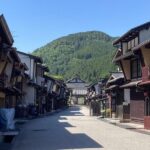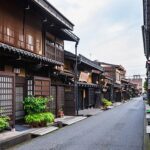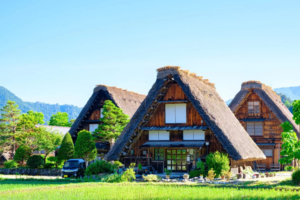
Nestled deep in the mountains of Gifu Prefecture, Shirakawa-go is one of Japan’s most iconic traditional villages, famous for its Gassho-zukuri farmhouses—steeply thatched wooden homes designed to endure heavy snow.
Together with the neighboring village of Gokayama, it was designated a UNESCO World Heritage Site in 1995, recognized as a rare, living example of Japan’s historic rural culture.
Shirakawa-go is not a museum but a fully inhabited village. Local residents still carry on the traditional way of life, preserving customs, architecture, and farming techniques passed down through centuries.
Visiting here feels like stepping into a world of snow-capped mountains, rice paddies, wooden houses, and timeless Japanese countryside scenery.
Contents
- 1 The Gassho-zukuri Farmhouses
- 2 Ogimachi Village – The Heart of Shirakawa-go
- 3 Shiroyama Viewpoint (天守閣展望台)
- 4 A Village of Four Distinct Seasons
- 5 Staying in a Gassho-zukuri Minshuku
- 6 Local Culture and Traditions
- 7 Local Food and Specialties
- 8 Etiquette and Respectful Behavior
- 9 Access
- 10 Why Shirakawa-go Is Special
The Gassho-zukuri Farmhouses
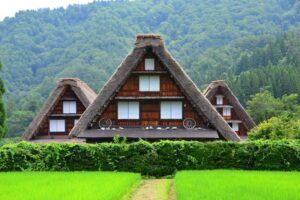
Architecture Born from Harsh Winters
The trademark of Shirakawa-go is the Gassho-zukuri house—literally meaning “constructed like hands in prayer,” referring to the steep, triangular thatched roofs that resemble the pressed hands of Buddhist monks.
Architectural Characteristics:
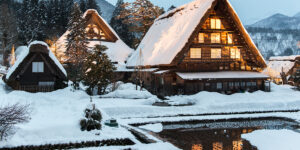
-
Steep 60-degree roofs prevent snow accumulation in winter.
-
Thick thatched roofing (kayabuki) provides exceptional insulation.
-
Built without nails, using wooden joints and ropes.
-
Three to four floors inside, with large attic spaces.
-
Attics were traditionally used for silk farming (sericulture).
-
Made largely from local timber, river stones, and natural materials.
These houses are extremely durable and warm—a necessity for surviving the region’s heavy snowfall, which can exceed 2 meters (6+ feet) in winter.
Several Gassho-zukuri homes operate as:

-
Folk museums
-
Tea houses
-
Minshuku (family-run inns)
-
Craft workshops
Others remain private homes, each with hundreds of years of history.
Ogimachi Village – The Heart of Shirakawa-go
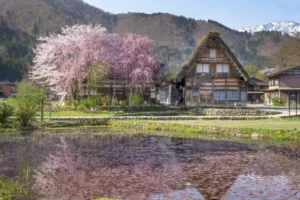
The most visited settlement is Ogimachi, the largest and most scenic Gassho-zukuri village.
Here, dozens of traditional farmhouses line narrow lanes surrounded by rice fields, streams, water wheels, and dramatic mountain peaks.
Must-See Spots in Ogimachi
-
Wada House: The largest Gassho-zukuri home, still inhabited by the Wada family.
-
Kanda House: Known for beautiful woodwork and historical exhibits.
-
Nagase House: Once the home of a local doctor; includes medical tools and family treasures.
-
Gassho-zukuri Open-Air Museum: Showcases daily life, farm tools, and seasonal customs.
Walking the village takes 1.5–2 hours, but many travelers stay longer to enjoy the serene countryside atmosphere.
Shiroyama Viewpoint (天守閣展望台)
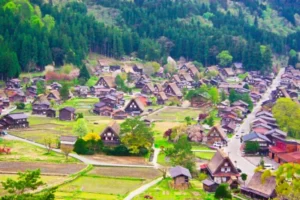
The Iconic Panoramic Photo Spot
The best viewpoint in Shirakawa-go is Shiroyama Observatory, overlooking the entire village with mountains behind it.
This is where the famous photographs of snow-covered Gassho-zukuri houses are taken.
A shuttle bus runs from the village center, but many visitors enjoy walking up (about 20–25 minutes).
A Village of Four Distinct Seasons
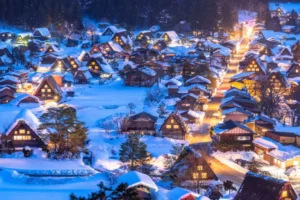
Shirakawa-go offers dramatically different landscapes throughout the year.
Spring
-
Cherry blossoms frame the traditional houses.
-
Rivers swell with snowmelt.
-
Rice paddies are filled with sparkling water for planting.
Summer
-
Bright green rice fields contrast with deep mountain forests.
-
Fireflies appear in July.
-
Traditional festivals fill the evenings.
Autumn
-
Brilliant red and gold foliage wraps the village.
-
Harvest season brings local celebrations and fresh mountain produce.
Winter
-
The village transforms into a magical world covered in deep snow.
-
Steaming chimneys and snow-laden roofs create postcard-perfect scenes.
-
On select weekends, the Winter Illumination lights up the Gassho-zukuri houses after dark (reservation required).
Each season offers entirely different scenery—many visitors return multiple times.
Staying in a Gassho-zukuri Minshuku
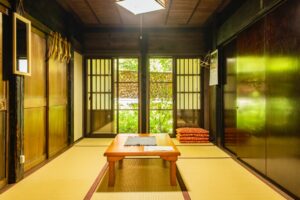
Experience Life Inside a 200-Year-Old Home
One of the most memorable ways to experience Shirakawa-go is to stay overnight in a minshuku, a family-run inn inside a traditional farmhouse.
Guests can experience:
-
Tatami rooms with futon bedding
-
A hearth (irori) where dinner is prepared
-
Seasonal local cuisine
-
A peaceful, lantern-lit village after the day-trippers leave
Meals often include:
-
Hida beef (local specialty)
-
Mountain vegetables (sansai)
-
Grilled river fish
-
Homemade tofu
-
Red miso dishes unique to the region
Staying in a minshuku allows you to see the quiet nighttime atmosphere that daytime visitors never experience.
Local Culture and Traditions
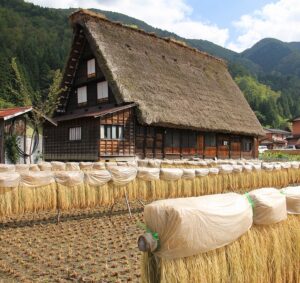
Shirakawa-go’s culture is shaped by isolation, heavy winters, and community cooperation.
Key Cultural Elements
-
Yui (結): A traditional system of mutual help for thatching roofs and maintaining homes.
-
Sericulture: Raising silkworms in the attic was once the main source of income.
-
Folk festivals: Seasonal celebrations honoring harvests, ancestors, and mountain spirits.
-
Rice cultivation: Terraced fields still define the landscape and farming lifestyle.
This strong sense of community helped preserve the village for centuries.
Local Food and Specialties
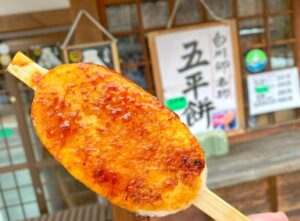
Visitors can enjoy regional dishes and snacks such as:
-
Hida beef (飛騨牛) – famous marbled beef from nearby Takayama
-
Gassho-shaped rice crackers
-
Warabi mochi (bracken-starch sweets)
-
Gohei mochi – grilled rice skewers with a sweet miso glaze
-
Soba noodles made with mountain spring water
-
Doburoku sake – unfiltered, milky rice wine produced locally
Small cafés and restaurants offer hearty rural cuisine with ingredients from the surrounding mountains.
Etiquette and Respectful Behavior

Shirakawa-go is a living community. Please:
-
Do not enter private homes.
-
Avoid photographing residents without permission.
-
Walk only on marked paths and roads.
-
Keep noise low—especially near minshuku areas.
-
Respect farmland and do not step into rice paddies.
These rules help preserve the harmony of the village.
Access
From Tokyo
-
Shinkansen to Kanazawa or Toyama, then bus to Shirakawa-go.
-
Or Shinkansen to Nagoya, then express train to Takayama, then bus.
From Takayama (Hida region)
-
Nohi Bus: 50 minutes
From Kanazawa
-
Hokuriku Railway Bus: 75 minutes
From Toyama
-
Bus: 60 minutes
Reservations are recommended during peak seasons.
Why Shirakawa-go Is Special
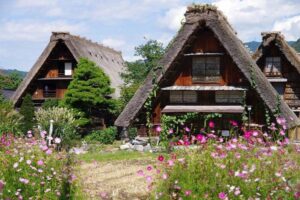
Shirakawa-go is one of the rare places where Japan’s historical rural culture remains actively alive, not recreated or staged.
Its beauty lies not just in the thatched houses, but in the living traditions, mountain landscapes, and quiet rhythms of village life.
Whether blanketed in snow, glowing with autumn colors, or surrounded by spring blossoms, Shirakawa-go offers a deeply atmospheric and unforgettable window into Japan’s past—one that continues to thrive in the present.
Related articles
Official Website
https://shirakawa-go.gr.jp/en/
Accommodation sites
Agoda
